 Artetsu Saria 2005
Artetsu Saria 2005
Arbaso Elkarteak Eusko Ikaskuntzari 2005eko Artetsu sarietako bat eman dio Euskonewseko Artisautza atalarengatik
 Buber Saria 2003
Buber Saria 2003
On line komunikabide onenari Buber Saria 2003. Euskonews y Media
 Argia Saria 1999
Argia Saria 1999
Astekari elektronikoari Merezimenduzko Saria

Only a small bunch of unknown heroes are enough to change the Globe for many people, making it better. Unknown just because a lack of recognition of their actions. One of these heroes is Dr. Argentino Rodolfo Arribalzaga.
He was born in Bragado, Buenos Aires Province, Argentina. His grandfather, José de Arribalzaga, arrived to Argentina in the second half of the XIX Century, between 1870 and 1880. José came from Bizkaia, which was sending his sons and daughters out to the world to find chances to progress. In his luggage, was lavishly hidden an ancient book containing old medicine’s formulas. It seems to be a great presage of what his grandson would do in the years to come. José de Arribalzaga was an excellent clockmaker. He got married to Josefa Yrigoyen (cousin of Hipólito Yrigoyen1). Settled down in Bragado city they had two children: Angel Gregorio and José Manuel who died as a young man.
Angel was born in 1890. He was an excellent musician. He taught at the National College and conducted the Bragado City Town Hall Orchestra. Also he conducted his own orchestra and used to play at the French Theatre (There sang Carlos Gardel2 in 1913 local historian Pedro Martín Ortellado infers) in the same city. Angel constituted a family with Amelia Lapeirade. They had two sons. Only one managed to survive.
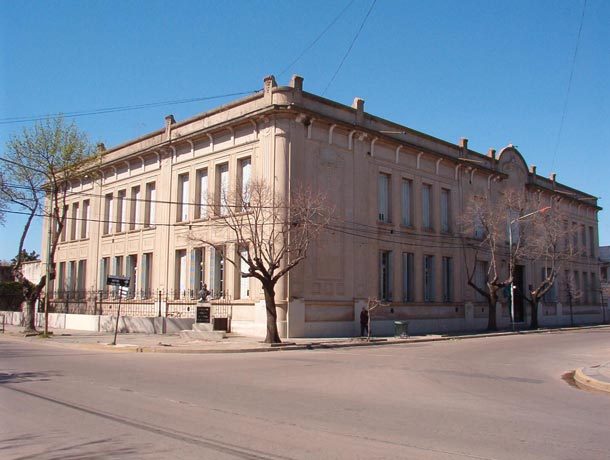
Public School Nº 1. Located a few yards from Rodolfo’s home,
here he assisted to initial levels of education.
Photo: Juan Manuel Scotti.
On May 18th 1913, A. Rodolfo Arribalzaga comes to the World. When he was a young boy, Arribalzaga had a lot of friends. He was very slim so he was called “Thin Kid”. Rodolfo loved to play football in the street. He began studying at Public School Nº1, a few yards from home on 121st Mitre St. There was Arribalzaga’s home till they move to Belgrano St. in the same city. He assisted to Secondary School at the National College and when he was 19 years old, in 1932, he moved to Buenos Aires city to start School of Medicine.
As a student at Buenos Aires University, he was exemplary. Arribalzaga was an enthusiastic of medicine. Beyond his great marks he ended his career in the lapse of six years, six months before according to the studying plan. His father disease pushed him to end the Medicine School as soon as possible. Angel Gregorio finally dies in 1941.
University times weren’t easy for Rodolfo. He never could buy a single book. During his firsts academic years he lived in Constitución neighborhood from where he walked every morning on his way to the School of Medicine. The trek took him one hour and a half. He attended to classes, then he ate his lunch (carefully carried from home) and after that he confined himself in the library till night. Then he started his way back home on foot. He couldn’t afford means of transport. Around the last years in university, Arribalzaga moved to his uncle’s home in Wilde, close to Buenos Aires city from where he kept assisting to classes.
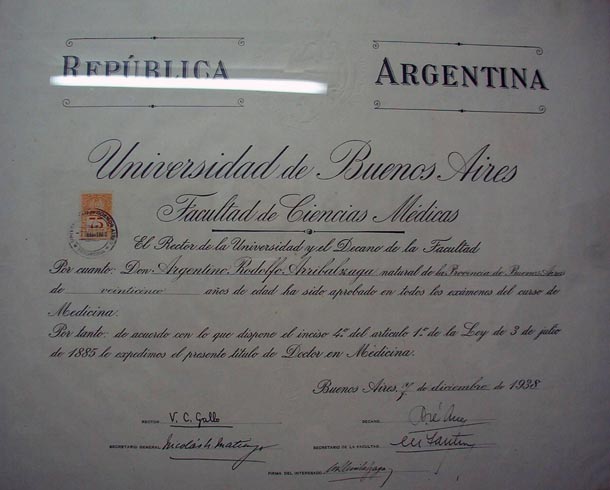
Diploma that qualifies Rodolfo as a medicine doctor.
Photo: Arribalzaga family private files.
As he couldn’t support himself his living, he married to Carmen Gevodan. She was a teacher and could support Rodolfo and herself till the moment Arribalzaga became a doctor. The first practice Arribalzaga owned in Bragado city was bought by his wife with her own salary. Carmen and Rodolfo had a child: Oscar Angel.
With high passion, Arribalzaga developed his profession in Bragado city. In the ‘40s, he paid special attention to isolated cases of a strange flu. It was called “The Italian Flu” and it killed most of those who where infected. It broke out mainly in rural areas and reached maximum levels in the years 1951, 1952, 1953 and 1954. Dr. Arribalzaga, warned by the first cases (circa 1940), he focused on the study of that strange disease full time, meanwhile other health professionals opted to ignore those sporadic cases. He wasn’t convinced that the clinical cases observed in patients matched with a flu case.
The endemic-epidemic focus started in Bragado, and it spread out rapidly reaching surrounding localities such as Alberti, 9 de Julio, Junín, Chacabuco and O’Higgins in 1958. In Bragado, in 1953 one person and a half died per day during 45 days, according to statistics.
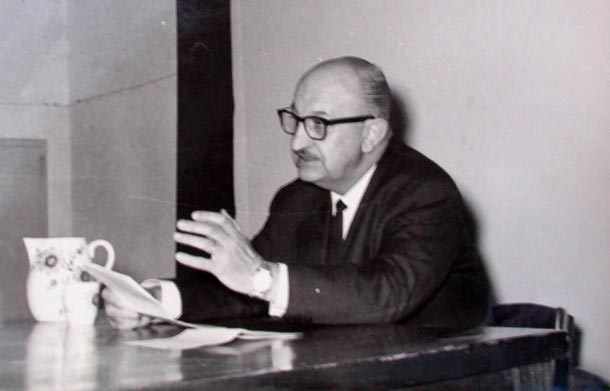
Dr. Argentino Rodolfo Arribalzaga expounding on AHF. June, 5th 1964.
Photo: Arribalzaga family private files.
Rodolfo alarmed called provincial authorities. Professional scientist teams arrived from the Tomás Perón Institute. They didn’t manage to find the cause. Also The Microbiology Institute Malbrán sent specialists: Dr. Villegas (leptospirologist) and Dr. Pochá (virologist) who unfortunately couldn’t find leptospira, virus or any specific pathogenic bacteria.
Dr. Arribalzaga used to visit sick persons accompanied by his son Oscar. Meanwhile he did physical examination; Oscar took photographs to the disease signs. In all cases found similar patterns: a characteristic type of breath, the tongue’s shape which seemed to be a parrot’s one, skin spots due to small hemorrhages. Sick people died because of inner hemorrhages.
Rodolfo observed that these cases didn’t obey to conventional treatments and began to treat them as he explains himself in the magazine “El Día Médico” in 1955. In the article he gives a detail of the pathology characteristics, its diagnosis and treatment.
Arribalzaga’s intuition, due to his intellect, academic formation, the intense dedication or the sum of all this, made Rodolfo to be accurate in early detection of the sickness which allowed an early treatment and to avoid, this way, hundreds of sure deaths. He insisted the cause was a viral infection, rather different from a leptospira’s (as his colleagues argued). Basic Arribalzaga’s treatment is used nowadays except by new medicines. He was desperately requested in the outbreak areas. He spent most of the day tripping with his helpful son from door to door assisting affection victims. One unlucky day, Oscar Angel caught the illness but his involved father treated him immediately. Oscar Angel says his father administered him so many injections that he couldn’t seat for three months. He was 12 years old. Since he was born, Oscar adds, he remembers his father dedicated to study that rare sickness.
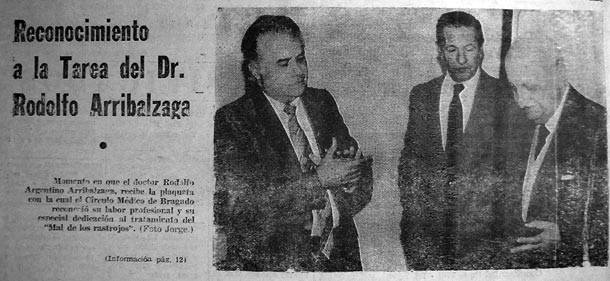
Dr. Arribalzaga is honored by the Bragado Medic Circle with a plaque in
1983.
Photo: Arribalzaga family private files.
Dr. Arribalzaga’s perseverant and despairing quest of the death’s cause cost him one day and night in prison. Oscar Angel Arribalzaga infers one night a patient died in the Public Hospital of Bragado. The sickness casualty hadn’t a family. Rodolfo in company of a hospital vigilant, practiced an autopsy in order to verify the cause of dying were several inner hemorrhages. As Rodolfo didn’t applied for the proper permission, someone called the police and won “one-day stop” at the police office’s dungeon.
Once the epidemic was controlled, Dr. Arribalzaga was invited to Russia and The United States Of America among other countries. He preferred keep working in Bragado’s area, helping his patients and assisting to medicine congresses in Argentina. His son says Rodolfo insisted his publications were the consulting sources and there was no need to go far. He was pleasant and felt himself honored with those invitations.
Arribalzaga used to find quietness up in the air. In 1948 he got the pilot degree and in society with three of his friends bought a Piper P-11. He enjoyed flying for hours contemplating the flat surface as a bird in the height. The only one airstrip in Bragado was in the rural area, at Echeverría (known as “The Basque”) lands. There, in the countryside, father and son met coming from different roads, the first by car, the second by motorbike to avoid displeasing feelings in Carmen (mother and wife) who said that with one crazy man in the family was enough. Rodolfo and Oscar took pleasure together sharing hours of peace up there. From time to time, Oscar says, his father allowed him to pilot the aircraft.
The disease that kept Dr. Arribalzaga awake today is well-known as Argentine Hemorrhagic Fever (AHF). It is caused by Junín virus (an Arenavirus3) and its reservoir is a little rodent, the corn mouse (Calomys musculinus). It transmits the virus throughout its saliva, urine and blood.
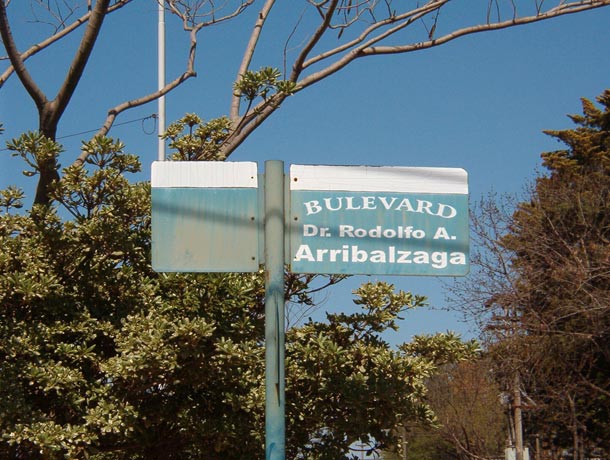
Baragado city honors Dr. Arribalzaga’s memory in a boulevard.
Photo: Juan Manuel Scotti.
The Calomys musculinus inhabits the Humid Pampa since 1.8 million years ago. In the 1940 decade the virus passed to human product of an ecologic unbalance due to the abusive and inappropriate use of pesticides. These chemicals exterminated its natural predators which kept corn mouse population in balanced levels.
This pathology has an incubation period of one-two weeks. The patient shows weakness, asthenia, fever, headache, joint ache, lack of appetite and platelets disorder. Current treatments include recovered patients plasma and optionally ribavirin.4
Rodolfo never bragged about his feat. He never did it. His feat consisted in discovering the treatment to a lethal illness and rescuing sick people from the arms of death, hundreds of them. However, at his hometown his effort was ignored, gratitude practically absent. In 1983, the Bragado Medic Circle honored him with a plaque. Dr. Arribalzaga dies in 1985 surrounded by his beloved family.
Today Bragado remembers him throughout a narrow boulevard in front of the Public Hospital which carries his miswritten name, Dr. Rodolfo Arribalzaga Boulevard.
Related Bibliography:
1 Hipólito Yrigoyen (1852 – 1933): Argentine politician. His father (Martín Yrigoyen) was Basque. Hipólito was President of Argentina between 1916 and 1922; and between 1928 and 1930. He also was police commissioner, president of the Scholastic Council of Buenos Aires, student of law, teacher of Civic Instruction, History and Philosophy, landowner and congressman.
2 Carlos Gardel (1890 – 1935): His birthplace remains in question: Uruguay or France. He was a charismatic tango singer and became the most popular tango singer of all times. His first steps in tango were acting in pubs and parties. From 1913 to 1925 made up a duet with José Razzano. He died in a tragic plane crash in Medellin, Colombia. His mortal remains rests in La Chacarita Cemetery, Buenos Aires.
3 Arenavirus: is a genus of virus, from Arenavirae family. Many arenavirus are pathogenic and transmit throughout animals, especially by rodents. Besides AHF, other illnesses caused by arenavirus are Lassa Fever (Lassa virus), Brazilian Hemorrhagic Fever (Sabiá virus), Hemorrhagic Fever (Whitewater Arroyo virus).
4 Ribavirin: An anti viral drug.